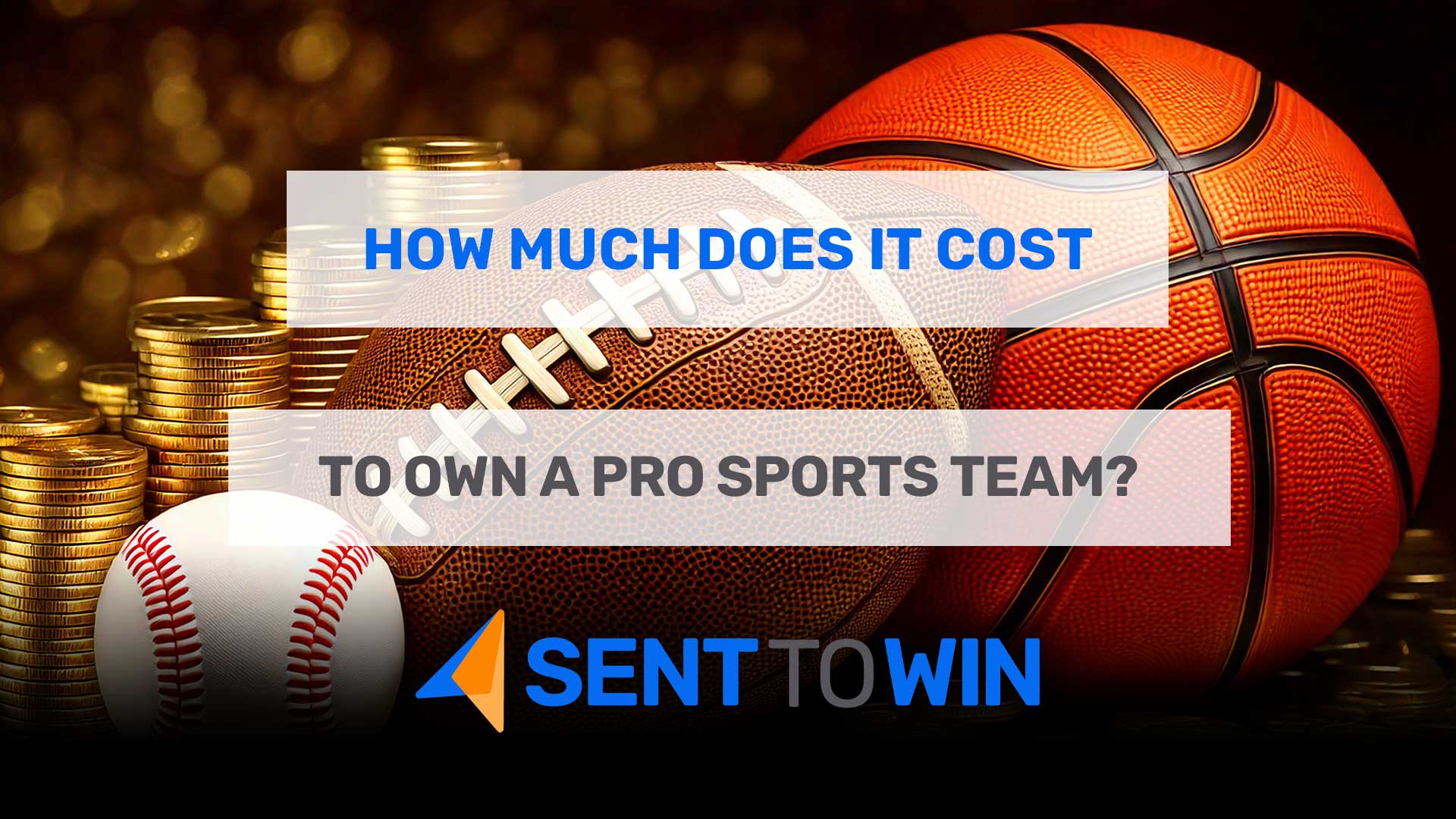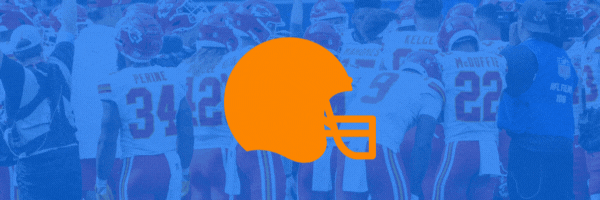How Much Does It Cost to Own a Pro Sports Team?
In today’s newsletter:
- How Much Does It Cost to Own a Pro Sports Team?
- Trump Tariffs Take Effect, Market Watch, and Super Bowl Math
- Raise Your Close Rate on Sales
Super Bowl LIX is only a few short days away, and as the nation (and world) gears up for one of the consistently most-watched media events of the year, we want to turn our attention to one of the largest moneymaking industries in entertainment: Sports.
Athletes capture the headlines when they land a historic contract – such as baseball’s Juan Soto scoring a $765 million, 15-year contract with the Mets last year or Patrick Mahomes’ $450 million, 10-year contract with the Chiefs, which just got restructured to potentially earn him even more. But less often do you hear about what sort of money the owners of these organizations have to shell out to buy a team, and the valuations, revenue, and brand equity that goes into figuring out what that team is really worth. Obviously professional sports teams bring in big revenue, but they have big costs, too. Is it enough to be a real source of cash flow to the owners, or is owning a pro team really just a “sandbox for billionaires”?
Every league has its own unique features, and the numbers vary from market to market, but today, we’re going to take a look at what it costs to own a pro-sports team, from independent to minor to major, and examine the results to see if this is a real asset or really expensive fun for people who can afford it.
We’ll start with the big leagues.
How Much Does a Major League Sports Team Cost?
The law of supply and demand is in full force and effect in the world of professional sports. When we consider the big 4 sports in the U.S. – Baseball, Football, Basketball, and Hockey – there are only a total of 124 teams. The United States has an estimated 813 billionaires in it, and Canada has another 67 or so. Additionally, there are around 10,000 individuals in the U.S. who are centi-millionaires (people with a net worth north of $100 million). Owning a major league sports team is a big status symbol, a potentially large money maker, and something that sounds like a lot of fun. You could see how the limited supply and broad appeal could drive the cost up among those with the wealth and inclination to buy into a team.
Some teams, such as the Miami Dolphins, have multiple owners, which opens the market up even further. Stephen Ross is the majority owner of this NFL team, with Gloria and Emilia Estefan, Marc Anthony, Venus and Serena Williams, and Fergie all joining him as minority owners. Additionally, 13% of the Miami Dolphins is owned by private equity, as of last year – something that is not common in the NFL. This team was valued at $8.1 billion (Although Forbes seems to think this is an inflated valuation).
Buying in, even fractionally, isn’t cheap.
The Philadelphia Eagles, who will be in the Super Bowl this weekend, are worth an estimated $6.6 billion. Purchased by owner Jeffrey Lurie in 1994 for $185 million, this team has grown precipitously in value over the last thirty years. With revenue of $650 million and an EBITDA of $158 million, Philly is a reliable moneymaker that operates on a surplus. It is the #8 most valuable team in the NFL.
With over $100 million in gate receipts alone (and the NFL has a short season), Philadelphia is able to make a killing selling media rights, image, and brand licenses for apparel and events, etc. to say nothing of the concessions and luxury/VIP experiences that they sell at games.
Sharp and successful owner that he is, Jeffrey Lurie also owns the Philadelphia Phillies, an MLB team worth an estimated $3 billion which he purchased in the 80s for $30 million.
In the NBA, the most valuable team is worth $9 billion (The Golden State Warriors), and the least valuable team is the Memphis Grizzlies, worth $3 billion.
Amazingly, when owners Joe Lacob and Peter Guber bought the Warriors in 2010, it was losing money. Today, it’s one of the most valuable sports teams in the world.
An NHL team costs around $2 billion on average, with the most expensive being the Toronto Maple Leafs ($3.8B) and the least being the Columbus Blue Jackets ($1B).
The most valuable MLB team is worth $7.6 billion (NY Yankees) and the least is worth $1 billion (Miami Marlins).
NFL teams range from $11 billion (Dallas Cowboys – though Forbes says $10 billion) to $5.25 billion (Cincinnati Bengals, though again, Forbes lowers this to $4.1 billion).
All things considered, if you want to own a professional major league sports team in the United States, you or your investment pool is going to have to come up with a minimum of $1 billion.
Because while some of these organizations do sometimes struggle with cash flow or an overly indebted balance sheet, by and large, a well-run pro team is a massive moneymaker.
Amazingly, pro sports teams have seen stark increases in value across the board in the past two decades, making them too expensive even for some billionaires.
So what about a minor league team or an independent league team, if you still want a taste of pro sports ownership?
How Much Does a Minor League Team Cost?
Wrapping your head around how the minor leagues work in various sports can be a little dizzying. In some sports, like basketball and baseball, there is an official minor league, and major league teams have partnerships or affiliations with particular minor league teams in order to develop talent for the big leagues. For the minor league teams themselves, they do a lot of local events, charity spotlights, and group outreach to make games feel like big events in (usually) small towns. But even when there is an official minor league, minor league teams can change affiliation from time to time, and new teams sometimes get started as well.
Take the Chattanooga Lookouts, for instance, a minor-league baseball team in Tennessee. The Lookouts were affiliated with the Cincinnati Reds from 1988-2008, but then they dropped that partnership and were a farm team for the Los Angeles Dodgers, until 2015, when they were with the Minnesota Twins. Currently, they’re with the Reds again. The Lookouts are a AA team, but there are other levels in the minors as well.
As far as revenue goes, the model has a lot of similarities to the major leagues. Minor league teams sell tickets to games, merchandise in the gift shop and online, concessions, and media rights – although media deals for minor league teams are more accessible for some sports than others.
In the official minor leagues affiliated with the NBA, NHL, NFL, and MLB, costs and valuations vary widely, but they’re certainly orders of magnitude more affordable than major league teams.
The drawback? Not all of them actually earn profits.
Bill Oram of the Portland Oregonian, discussing a new minor league team affiliated with the Trailblazers said it very straight-forwardly, saying that the “G-League” (the NBA’s official minor league) is “not a revenue generator.” It’s used mostly for talent development among coaches and players, as well as a place to land for talented high school basketball players who did not get into college but are strong prospects for a pro career. Since the NBA’s minimum age is 19, something was needed to fill the gap.
Operational costs for a G-League team can run around $2 million, and some rumor sources say that starting a new G-League affiliate team from scratch costs around $10 million in total. But the NBA’s minor league is interesting because essentially all teams are actually owned by their pro-team affiliates.
So, sad to say, unless you own an NBA team, owning a G-League Team is most likely impossible. If you want to own a basketball team without spending billions of dollars, you’ll be looking at an independent pro league, such as TBL, where you can expect to spend a comparably modest sum of 6 to 7 figures to own a team like the Potawatomi Fire or the San Diego Sharks (disclosure: the San Diego Sharks are owned and operated by the Founder of Sent To Win).
The NHL has its own dedicated minor leagues called the AHL and the ECHL, which, like the NBA minor leagues, are also typically owned by the teams they feed into. This is also a development league and is used to farm new prospects, as well as a place to put veteran NHL players with time left on their contracts but who are no longer putting up the numbers. Here again, owning a minor-league hockey team isn’t going to be possible in general unless you own an independent-league team.
When it comes to football, the NFL’s minor league is basically just the NCAA. College football is so popular, well-funded, and widespread, that the pro football league hasn’t really needed to farm out official minor leagues. Still, some independent minor leagues do pop up from time to time (such as the XFL) but in general, they seem to struggle to stay afloat financially or to attract much interest from fans, given the strong competition from pro teams, college teams and, in some cases, even legacy high school football teams.
However, the United Football League launched just last year, a merger between the XFL and the USFL that sought to solve financial problems for both organizations, so we will see if they find a niche going forward. It is difficult to find exact numbers, but at the moment, a UFL franchise appears to cost between $10 million and $20 million dollars – and don’t expect to turn a profit for a while. Some say annual losses of up to $10 million per team should be expected.
To be fair, there are some more accessible opportunities out there, especially for those who are willing to consider sports like soccer, rugby, and others. An online marketplace for prospective owners of professional sports teams called “The Sports Advisory Group” maintains a listing of investment opportunities that you can review online. Currently, there are minor league baseball teams, professional tennis teams, pro soccer teams, Canadian basketball teams, and others available for sale.
TL;DR
After a quick look through the numbers, the question remains: Can a moderately successful businessperson maneuver their way into ownership of a pro-sports team, fulfilling a childhood dream and raking in the revenue?
It’s very unlikely. Minor league teams are far less expensive, but they often require pre-existing affiliation with their parent leagues, and in general, minor league sports exist to support the major leagues – not to earn profit. Owning a successful minor league team is possible, but you may have to look outside of the United States, choose a less popular sport, or get creative. Major league teams cost a minimum of $1 billion, which is a lot, even for a very successful investment pool.
The moral of the story is, unless you inherit ownership of a team, find a diamond in the rough opportunity in the minor leagues, or earn your way onto the billionaires list, owning a pro sports team just is not typically accessible even for a very successful business owner.
At least we can always buy a few shares of the Green Bay Packers, the only pro sports team owned by the fans.
INDUSTRY INSIGHTS
Trump Tariffs Take Effect, Market Watch, and Super Bowl Math
Trump Tariffs Take Effect
New tariffs from Canada, Mexico, and China took effect on Saturday, in accordance with President Trump’s orders. The White House says that these “aggressive” tariffs (25%, 25%, and 10% respectively) are in retaliation for the “invasion of illegal fentanyl” that has caused a sharp rise in drug poisoning deaths, particularly in Americans aged 18-45.
Trump seems to be using the tariffs as a way of pressuring Mexico and Canada to control their borders, a high priority for the Trump administration. So far, it seems to be working. Trump paused the Mexico tariffs for one month on Monday, after Mexico’s president agreed to send 10,000 Mexican troops to the border, in what supporters are calling a win for the tariffs. It’s a good thing, too. A disastrous performance on the stock market Monday was curbed by Trump’s announcement of the pause on Mexican tariffs. The market then began climbing back. Canada declared a 25% retaliatory tariff on U.S. goods before tensions settled down Tuesday, when Canada agreed to sit down to renewed negotiations with the U.S. to tighten the shared border and combat the flow of illegal drugs. Trump agreed to pause the Canadian tariffs for 30-days as well, easing fears of a trade war in North America.
China has declared a 15% retaliatory tariff on U.S. goods, but some see this as a sign of Chinese restraint and perhaps a good omen for talks between the U.S. and China that are currently taking place. Trump has suggested replacing the federal income tax with tariff revenue, but some economists say this is impractical.
Market Watch
Markets have moved up tentatively early this week, as investors try to navigate the possibility of trade wars coming from the Trump tariffs. Gold hit a new all-time high of $2,845.14/oz, as investors sought shelter from the economic turbulence stemming from international trade.
The Fed has decided not to cut interest rates this time around, in a decision that the President called “the right thing to do.” Recent inflation reports had shown creeping increases, and the risks of lowering rates were too clear to ignore. The average 30-year fixed-rate mortgage has quietly slipped under 7% this week, in a reversal of last month’s trends.
Bitcoin has been up and down this past week, between a high of $105k and a low of $92k. Still, despite the volatility, it remains near all-time highs.
Super Bowl Math
The average ticket price to attend Super Bowl LIX in New Orleans was just over $8,000 last week, down about 14% compared with the same time last year, but the market for these tickets has since plummeted even further, perhaps due to “Chiefs fatigue.”
The stadium hosting this year’s game has a maximum capacity of 83,000 (though something like 73,000 seats will be available for the Super Bowl), and the viewing audience online and on television is expected to surpass 200 million. With such jaw-dropping viewership, it’s no wonder that 30 seconds of advertising time on the television broadcast will run $8 million – a new record high.
For all of that money being passed around, one figure is quite a bit lower than you would expect: Halftime performer Kendrick Lamar will earn less than $1,000 for his performance. The Chiefs are the betting favorites to win this year, and if they manage to pull off a victory, they’ll be the first team in NFL history to win 3 Super Bowls in a row.
Sunday School
Q. Who wrote the most books in the Bible?
A. Paul with 13 (or 14 if you count Hebrews), but as his contributions are made up of epistles, or letters, they are shorter than some of the other contributors’ works. Moses is considered to have written the largest chunk of the Bible, by word count.
 Not only did Jerry’s salesmanship and soft skills leave something to be desired, even his begging needed work.
Not only did Jerry’s salesmanship and soft skills leave something to be desired, even his begging needed work.
TIPS & TRICKS
Raise Your Close Rate on Sales
As an entrepreneur goes from starting a business to growing that business, there are bound to be some growing pains. To make matters more complicated, a lot of people start a business because they are good at providing a certain service, not because they are necessarily gifted or experienced in the subtle art of building successful companies. A lot of entrepreneurs realize early on, with some shock, that sales is suddenly a huge part of their respective lives. Not everyone is a natural salesperson, and a little bit of strategy can go a long way.
Today we want to focus on how to turn a higher percentage of your leads into paying customers, with three tips to consider as we move ahead in 2025.
Change the Dynamic
There’s no magic bullet in selling, and finding just the right words can only get you so far. What does make an outsized difference, however, is the social dynamic behind the selling situation. Thankfully, no magic required.
All too often, people who are not natural salespeople think of sales as a somewhat slimy activity. The stereotype of the slick, fast-talking salesman who pressures or tricks unsuspecting people into buying something they don’t want factors in here – but it doesn’t have to be that way. The framing needs to change.
People who don’t want what you are selling are by definition, bad prospects. Chasing those people down isn’t good for you or for them. That leaves the people who are the sort of people who would enjoy what you are offering. In that case, there is no need for pressure, underhanded tricks, or anything slimy at all. Remember that you have something valuable to offer, and by selling to a qualified prospect, you’re helping them solve a problem at a fair price.
All of a sudden, sales becomes less about convincing and more about assisting. Help people who need your product find you and get that product.
No greasy sales tactics required.
Remember the lesson of Joe Girard, the greatest car salesman of all time who was famous for the rapport and relationships he built with customers, without being pushy:
“I never sold a car in my life. I sold a Girard.”
Reduce the Red Tape
The principle here is simple: How can you reduce the number of steps it takes for a customer to get you payment and to receive your goods?
In e-commerce, there is a pesky consumer habit called “cart abandonment.” A lot of times people will browse items on a website, select the things they’d like to buy, and then somewhere between browsing and checking out they just leave, and often they don’t come back later.
Being reminded about your abandoned cart could help, and yet it’s all too easy for that sort of thing to become annoying and cloying.
The solution? Make checking out easy and fast. Once a customer decides “yes,” they should be 99% of the way through the process.
Amazon revolutionized online sales with their “one-click” patent so that customers didn’t have to re-enter all of their info every time they bought something. They understood this principle better than anyone, so we ought to take a lesson from them.
E-commerce is one thing, but every realm of the marketplace has its own version of “cart abandonment.” What is it in your industry, and how can you lower that barrier? If you’re selling cars, is there any way you can make the paperwork take 10 minutes instead of 30 minutes? Can you consolidate 4 forms into 2? Can you gain information when people begin looking at your product so that it’s easy to run a transaction as soon as they are ready to say “yes”?
Customers want turn-key solutions. Don’t let a sale slip through your fingers because of a morass of red tape.
Hire a Professional
In the process of building a business, a craftsman needs to start focusing on sales at a certain point – but depending on the size and growth of your company, this, too, can become working in your business instead of on your business. If you have gotten to a sufficient size, it may be time to hire that natural salesperson to spend all of their time focused on bringing in new customers so you can do the things that only an owner can do – casting vision, product-line expansion, strategic partnerships, new market entry, etc.
Maybe it feels like a cop-out to list “hire a salesman” in tips for increasing your close rate, but it shouldn’t. There’s nothing wrong with outsourcing your weaknesses to someone who is excellent at those key tasks.
In the early days, this may or may not be an option, but at some point, the fastest way to improve your close rate is to hire a good closer.
Never forget the immortal lesson of Jim Collins, writer of the business classic Good to Great: “If we get the right people on the bus, the right people in the right seats, and the wrong people off the bus, then we’ll figure out how to take it someplace great.”
Quick Hits
- Relevant says that it’s time for the season of the “influencer pastor” to come to an end.
- The FDA approves a potentially revolutionary drug, Journavx: A non-opioid painkiller “without the risk of addiction.”
- Mainstream music artist “Jelly Roll” and CCM artist Brandon Lake are collaborating on a new song called “Hardfought Hallelujah.”
- CNBC reports that millennials are chasing a very different kind of retirement compared with previous generations.
- As prisons are closing nationwide, some are being converted into “stylish apartments.”
- Chris Hodges, founding pastor of Church of the Highlands (one of the largest churches in the country) has announced that he is stepping out of the lead pastor position to take a more active role in Highlands College.
- Forbes says it may be time to start investing in bonds.
- Celebrity Investor Kevin O’Leary calls Costco’s decision to double down on DEI policy “bad for business.”
For Kingdom Leaders, By Kingdom Leaders
Bringing Kingdom-minded leaders like you fresh perspectives and insights on business, finance, and leadership trends.








